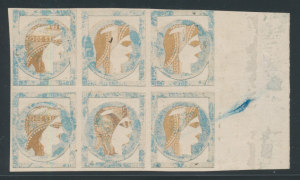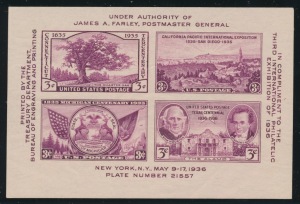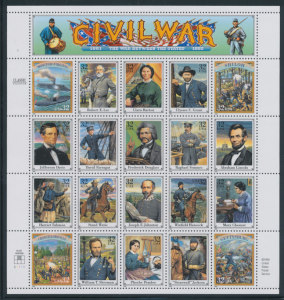Monthly Archives: December 2014
- Posted December 31, 2014
- Posted December 29, 2014Read more »
 Most collectors feel that specializing in a single country qualifies them to state that they are a "specialist" when it comes to their philately. But many collectors go even further than just one country and collect a single issue such as the Washington Franklin issue of the United States. Some go even further than that and collect the plate numbers and plate number blocks and some go even further than that and collect initials that are found in the side corner margins of Washington Franklins. These initials are a form of accountability markings to let people know after a stamp was printed who was responsible for handling the plate. There are three types of initials found on these stamps (in case you were wondering whether these issues could be specialized even further). There are Printers Initials that are found in side margins and are the initials of the printer who last printed from that sheet. There are siderographer initials which are usually found in the lower left corner
Most collectors feel that specializing in a single country qualifies them to state that they are a "specialist" when it comes to their philately. But many collectors go even further than just one country and collect a single issue such as the Washington Franklin issue of the United States. Some go even further than that and collect the plate numbers and plate number blocks and some go even further than that and collect initials that are found in the side corner margins of Washington Franklins. These initials are a form of accountability markings to let people know after a stamp was printed who was responsible for handling the plate. There are three types of initials found on these stamps (in case you were wondering whether these issues could be specialized even further). There are Printers Initials that are found in side margins and are the initials of the printer who last printed from that sheet. There are siderographer initials which are usually found in the lower left corner - Posted December 26, 2014Read more »Before the advent of the Giori Press, which allowed easy multicolor printing, the United States Post Office issued primarily single colored stamps. This was because bi color stamps, under the traditional engraving process, required different runs through the press for each color. This was time consuming and created "registration" problems, that is problems of the colors aligning correctly one to the other. But other, more disastrous, problems, such as inverts, could occur.To 1960, the United States issued less than 20 bi colored stamps. The first were the higher values of the 1869 with two of the three values being known inverted. The next issue was 32 years later, the 1901 Pan American issue and two of these values are known inverted. And of course there is the famous 24
- Posted December 24, 2014Read more »There are many aspects of United States Philately that simply don't exist with the stamps and the collecting of other countries. Certainly, the emphasis that American collectors have placed on Revenue collecting is unparalleled in the philatelic world. Revenues are stamps that are issued by governments for tax paying rather than postal purposes.United States collectors have a huge number of these stamps to choose from, not only in the general Revenue category but in specialized revenues as well. In the post Civil War period the US levied taxes on patent medicines, match books and perfumes. Companies had to pay so much per bottle or pack sold and a Revenue stamp was required on the bottle to indicate that the tax had been paid. Companies could use a United States revenue stamp, but the Treasury department also
- Posted December 22, 2014Numismatics presents a problem so profound that it is ignored by most coin collectors: what to collect. Coins have been issued for well over 3000 years by thousands, if not tens of thousands, of political entities. This has presented a problem for coin collectors that we stamp people have not yet had to face. There are not catalogs that list all the coins that have ever been issued as we have in stamps. And how could there be? There are too many coins from too many places that are no longer self governing. And many coin issues are undocumented, issued long before agencies of the state formally ordered such things. Such coins were issued by whim, sometimes with little state oversight and new varieties of ancient and medieval coinage are constantly being discovered. Stamps have only been around for 170 years, all in the literate period of world history, where researchers have been able to document issues, know press runs and list varieties almost as they were issued. In the lastRead more »
- Posted December 19, 2014Read more »
For stamp dealers coming of age in the 1960s the stamp world was replete with Europeans who had escaped from Hitler and Stalin. Most were Jews, though looking back through the less opaque lens of our time, I know several were political escapees and at least one was fortunate enough to get out or he would have worn a pink star before he was exterminated. In 1965, the average philatelic refugee was about fifty, so in the prime of his professional life. And there were scores of them on the American philatelic scene.
The reasons that refugees were overrepresented in the stamp world are several. First, it was easier for stamp dealers to get out of Europe than it was for many other "inferiors" whom the Nazis planned to exterminate as they moved across Europe. Many people who knew they were on the list of those whom the Germans would kill simply waited too long to leave and by the time came where they felt they had to go, they no longer could. - Posted December 17, 2014Read more »
Seigniorage is the profit that governments make on securities that they issue, on which they don't pay interest, and that are retained unused by the public. Cash in mattresses represents a form of seigniorage and, more than anything else, old face value postage stamps held by collectors do as well. The money that collectors have tied up in mint stamps represents an interest free loan to our post office. And because most mint stamps held by collectors will never be used, the profit to the post office is the value of those stamps held by collectors (Private companies issue gift cards and they are required by accounting rules to bring the unused portion of these cards into income-this is a sort of private seigniorage). For many years philatelic commentators have speculated that seigniorage was the reason that our Post Office pushed philately so hard and the reason that so many new issues had esoteric themes ( designed to entice noncollectors into buying them and putting them in a drawer).
- Posted December 15, 2014Read more »Classic French stamps are among the most interesting. The first issues of France are printed by a method of printing called typography. Unlike engraved plates, typography relies on plates that hold a design by having an ink-holding agent that is applied to the plate do the printing rather than having the metal plate itself hold the ink, as is the case in engraving. Typography is a simpler printing method than engraving, but in the hands of capable printers can produce a fine result. But the non-metal aspect of the printing agent means that wear is rapid, and for this reason typography tends not to be used for large printing orders as the quality of the print tends to degrade as the plates wear. The reason why the printers of the first French issues chose not to engrave their stamps is unclear. Perhaps they were unsure that stamps would catch on and that millions would soon be required, and their decision was based on the fact that typography is far cheaper than engraved. But
- Posted December 12, 2014
- Posted December 10, 2014Every country has peculiarities of its specialization. The Germans have coil numbers printed on the back of stamps and collect their coils in strips of eleven to prove that the stamps didn't come from a sheet which was printed with rows no larger than ten. The French collect gutter pairs with plate numbers, called millisimes. The Swedes measure the perfect centeredness of their socked-on-the-nose cancels. But no country collects their revenue stamps like the United States. No country includes such a broad array of revenues in the specialty catalogs as are listed in the Scott US Specialized catalog. No country lists Privately issued revenues such as the US Match and Medicines. And finally, no country has so many or so avidly collected Duck Stamps. The Hunting Permits, or Ducks, as they are called are issued each year and have been since 1935 to pay the Federal tax on Duck Hunting. They are probably the greatest crossover philatelic item. More non stamp collectors collect DuckRead more »
- Posted December 08, 2014Read more »Coin collecting has been dominated over the last fifty years by third party grading issues to the point where few serious numismatists buy non-graded coins. Eager grading services have tried to push into philately hoping to enlarge their fee base. So far it hasn't worked. Some collectors have become enamored of graded stamps but most think that it is inconvenient and costly. There are several reasons why third party grading is popular for coins and why it has largely failed in philately, despite two separate, (one in the late 70's and the other a few years ago) highly promoted, and well funded grading service attempts to make it stick. Third party grading has created changes in numismatics that has made it very different from philately, with which it traditionally has shared many characteristics.Third party grading encourages investors over collectors. As philately stands now, collectors usually spend a
- Posted December 05, 2014Read more »Herman Herst Jr.'s book Nassau Street is probably the most readable and enjoyable of all the philatelic canon. It is a series of stories and reminisces about philately in the 1930s and 1940s loaded with good anecdotes about many of the giants of our hobby along with reflections on where the hobby was in the year that the book was published (1960) and where stamp collecting had come from. The book was immensely popular and was on the New York Times' bestseller list for a time after its publication, indicating appeal outside the hobby. Copies are available from used booksellers on Amazon, so, if you want one, there are a few that are still available. But books like this are hard to find, and collectors who came into the hobby after Mr. Herst's retirement have little access to the joys of his philatelic vision.This situation exists because the copyright laws in the United States that
- Posted December 03, 2014Read more »
Stamp collecting has always been an International hobby and there is no better example of this than the issue of measuring perforations. Europeans and Americans differ on how they take temperature(Celsius versus Farenheit) and distance ( miles versus kilometers). But collectors all around the world use the same types of perforation gauges and count perfs the same way. When we call something perf 12 all collectors mean 12 perforation hole per two centimeters. This early agreement on perfs came without any effort. The French and the Belgians were the world's philatelic leaders in the mid Nineteenth Century. They produced the first albums and catalogs and so it was to them that later catalog makers from other countries turned when it came time to list differing perforation varieties.
For the most part the early Scott catalog copied the differing national sections of the foreign catalogs, using a pirated version of Yvert for France and Michel for Germany. So it was natural to pick - Posted December 01, 2014How history is remembered is one of the best ways of determining how a people wishes to understand itself. Currently we are in the midst of the 150th anniversary of the Civil War and this conflict, and the way that it is taught and learned and understood tells us much about ourselves in the early 21st Century. The sheet illustrated above is a USPS 1994 sheet commemorating the Civil War. It is evenly divided between Northerners and Southerners, slaveholders and those who opposed the ownership of human beings. Clearly, 150 years after this great war, which killed nearly as many Americans as all of our other war combined, the consensus that has emerged is that this war was some great cosmic tragedy, two honorable sides on a collision course with no one really at fault. But the Civil War was not inevitable and to believe so is not only a misreading of our history but a misreadingRead more »








